From c. 100—c. 400’s AD the Gentile Roman artists in the catacombs painted the heroes of their faith on the rough walls of the underground tombs as everlasting examples of perseverance and courage in times of mortal danger. Christians had been killed since Nero’s First Imperial Persecution began in c. 64 AD when Nero burned down Rome (the “Magnum incendium Romae”) and blamed it on the Christians.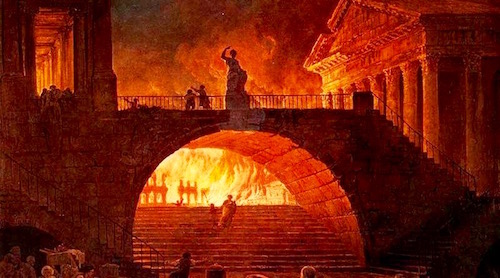
CLICK HERE read article on Nero the Arsonist
The catacombs were first dug in order to find space to bury Romans, but the catacombs of Rome are now relevant and studied because Christians chose to honor their dead in secret in those underground chambers. Their stories and their beliefs adorn the walls of their catacombs.
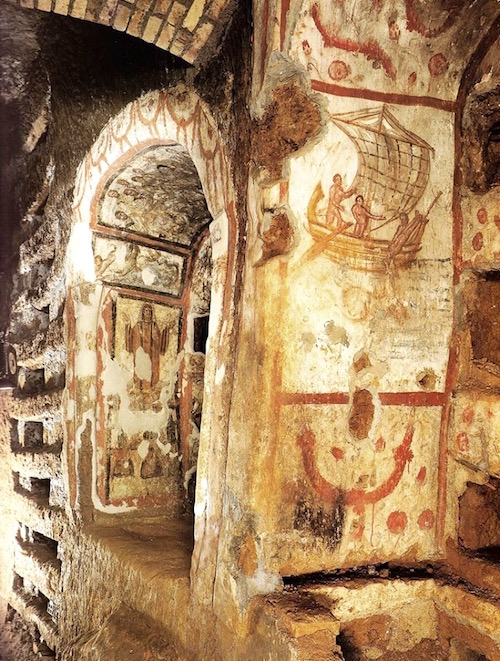
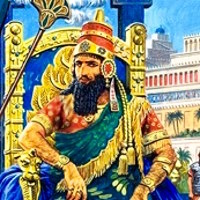
They often did fresco (“painting on wet plaster on a wall or ceiling”) paintings on the moist walls depicting Hebrew Old Testament people who were persecuted like they were. The Three Holy Children in the fire was a constant theme. The famous Babylonian King Nebuchadnezzar (reigned 605-562 BC and is mentioned over 90 times in the Old Testament) destroyed Jerusalem in 586 BC.
He took the young Daniel, his friends Shadrach, Mesach, Abednego and other Jews into exile in Babylon (below), the largest city in the world at that time covering c. 2,500 acres.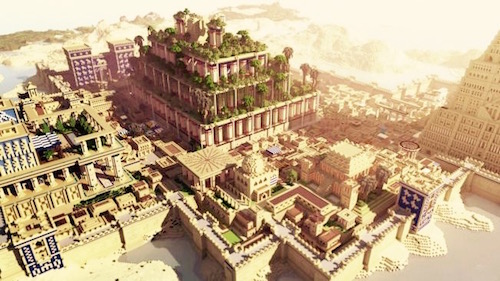 Notice the above image of ancient Babylon features Nebuchadnezzar’s creation for his wife Amytis—-the Hanging Gardens of Babylon, one the Seven Wonders of the Ancient World. Daniel and friends Shadrach, Mesach, and Abednego actually saw this ancient Wonder, but there is no Biblical mention of it. They had too many adjustments and “troubles” to do much sightseeing.
Notice the above image of ancient Babylon features Nebuchadnezzar’s creation for his wife Amytis—-the Hanging Gardens of Babylon, one the Seven Wonders of the Ancient World. Daniel and friends Shadrach, Mesach, and Abednego actually saw this ancient Wonder, but there is no Biblical mention of it. They had too many adjustments and “troubles” to do much sightseeing.
CLICK HERE for article containing information Hanging Gardens
The young Jewish men’s hometown of Jerusalem was a backwater village of c. 125 acres. The provincial Jews not only had to adjust to the different cultures and distractions of Babylon with its many people, different languages and foods, strange habits and dress, big temples and numerous gods and idols, but they had their faith in the one God tested. Daniel’s three friends were, like the early Christians, tormented and tortured because they refused to worship Babylonian idols. The whole story is told in Daniel 3:1-29.
 “King Nebuchadnezzar made an image of gold, ninety feet high and nine feet wide, and set it up on the plain of Dura (modern mound called Douair southeast of Babylon) in the province of Babylon. He then summoned the satraps, prefects, governors, advisers, treasurers, judges, magistrates and all the other provincial officials to come to the dedication of the image he had set up….the herald loudly proclaimed, ‘This is what you are commanded to do, O peoples, nations and men of every language. As soon as you hear the sound of the horn, flute, zither, harp, pipes and all kinds of music, you must fall down and worship the image of gold that King Nebuchadnezzar has set up. Whoever does not fall down and worship will immediately be thrown into a blazing furnace.
“King Nebuchadnezzar made an image of gold, ninety feet high and nine feet wide, and set it up on the plain of Dura (modern mound called Douair southeast of Babylon) in the province of Babylon. He then summoned the satraps, prefects, governors, advisers, treasurers, judges, magistrates and all the other provincial officials to come to the dedication of the image he had set up….the herald loudly proclaimed, ‘This is what you are commanded to do, O peoples, nations and men of every language. As soon as you hear the sound of the horn, flute, zither, harp, pipes and all kinds of music, you must fall down and worship the image of gold that King Nebuchadnezzar has set up. Whoever does not fall down and worship will immediately be thrown into a blazing furnace.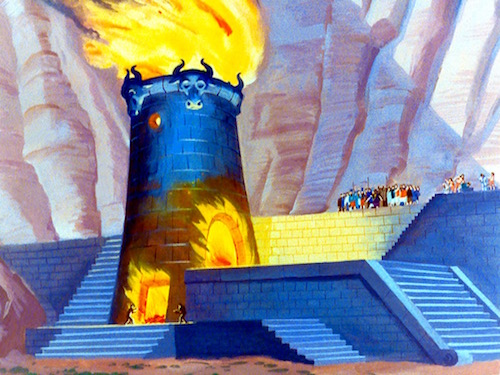 “….some astrologers came forward and denounced the Jews….Shadrach, Meshach, and Abednego…pay no attention to you, O king. They neither serve your gods nor worship the image of gold you have set up….Furious with rage, Nebuchadnezzar summoned Shadrach, Meshach and Abednego…and said to them, ‘Is it true Shadrach, Meshach and Abednego, that you do not serve my gods or worship the image of gold I have set up?….if you do not worship the image, you will be thrown immediately into a blazing furnace. Then what god will be able to rescue you from my hand?’….(they) replied to the king, ‘O Nebuchadnezzar, we do not need to defend ourselves before you in this matter. If we are thrown into the blazing furnace, the God we serve is able to save us from it, and he will rescue us from your hand, O king. But even if he does not, we want you to know, O king, that we will not serve your gods or worship the image of gold you have set up’
“….some astrologers came forward and denounced the Jews….Shadrach, Meshach, and Abednego…pay no attention to you, O king. They neither serve your gods nor worship the image of gold you have set up….Furious with rage, Nebuchadnezzar summoned Shadrach, Meshach and Abednego…and said to them, ‘Is it true Shadrach, Meshach and Abednego, that you do not serve my gods or worship the image of gold I have set up?….if you do not worship the image, you will be thrown immediately into a blazing furnace. Then what god will be able to rescue you from my hand?’….(they) replied to the king, ‘O Nebuchadnezzar, we do not need to defend ourselves before you in this matter. If we are thrown into the blazing furnace, the God we serve is able to save us from it, and he will rescue us from your hand, O king. But even if he does not, we want you to know, O king, that we will not serve your gods or worship the image of gold you have set up’

“….Nebuchadnezzar was furious with Shadrach, Meshach and Abednego….and commanded some of the strongest soldiers in his army to tie up Shadrach, Meshach and Abednego and threw them into the blazing furnace. So these men, wearing their robes, trousers, turbans and other clothes, were bound and thrown into the blazing furnace….Then King Nebuchadnezzar leaped to his feet in amazement and asked his advisers, ‘Weren’t there three men that we tied up and threw into the fire?’ They replied, ‘Certainly, O king.’ He said, ‘Look! I see four men walking around in the fire, unbound and unharmed, and the fourth looks like a son of the gods.’ “Nebuchadnezzar then approached the opening of the blazing furnace and shouted, ‘Shadrach, Meshach and Abednego, servants of the Most High God, come out! Come here!’ So Shadrach, Meshach and Abednego came out of the fire and the satraps, prefects, governors and royal advisers crowded around them. They saw that the fire had not harmed their bodies, nor was a hair of their heads singed; their robes were not scorched, and there was no smell of fire on them.
“Nebuchadnezzar then approached the opening of the blazing furnace and shouted, ‘Shadrach, Meshach and Abednego, servants of the Most High God, come out! Come here!’ So Shadrach, Meshach and Abednego came out of the fire and the satraps, prefects, governors and royal advisers crowded around them. They saw that the fire had not harmed their bodies, nor was a hair of their heads singed; their robes were not scorched, and there was no smell of fire on them. “Then Nebuchadnezzar said, ‘Praise be to the God of Shadrach, Meshach and Abednego, who has sent his angel and rescued his servants! They trusted in him and defied the king’s command and were willing to give up their lives rather than serve or worship any god except their own God. Therefore I decree that the people of any nation or language who say anything against the God of Shadrach, Meshach and Abednego be cut to pieces and their houses turned into piles of rubble, for no other god can save in this way.’” Daniel 3:1-29
“Then Nebuchadnezzar said, ‘Praise be to the God of Shadrach, Meshach and Abednego, who has sent his angel and rescued his servants! They trusted in him and defied the king’s command and were willing to give up their lives rather than serve or worship any god except their own God. Therefore I decree that the people of any nation or language who say anything against the God of Shadrach, Meshach and Abednego be cut to pieces and their houses turned into piles of rubble, for no other god can save in this way.’” Daniel 3:1-29
It is obvious why this Old Testament story was painted over and over again on the walls of the catacombs where the remains of so many Christians, killed because they would not worship Caesar or the images of the Roman gods, were buried. For the early Christians like their Biblical counterparts, it was The STATE VERSUS THEIR GOD. In the Catacomb of Priscilla the three Hebrews are in the flames, their hands raised in praise like an orant, a prayer. A dove hovers over them, the symbol of the Holy Spirit, the Comforter, the “one who looks like a son of the gods” in the fiery furnace.

In the Catacomb of Domitilla the son of god figure is seen in the furnace with the three. In the Cemetery Maius the hand of God is stretched down to the three from above. In Marcus and Marcellinus the three young men, dressed in Mesopotamian attire and hats, are in the act of refusing to obey Nebuchadnezzar, painted as a serious-looking man wearing, not the garb of a Babylonian king, but the toga and cape of a Roman emperor. Here, clearly, is the analogy between the three men in Babylon and the fiery deaths of Christian martyrs in Rome.
It was not unusual for the Romans to burn Christians alive. In the 1st Imperial persecution under Nero, he dipped Christians in pitch, impaled them on sticks, set them on fire and used them as torches to light his evening banquets (as depicted in the painting below).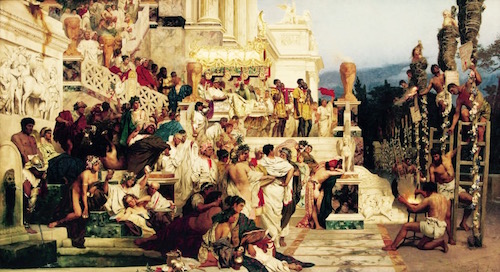 In catacomb art the story of Daniel in the Lion’s Den is companion to many of the paintings of the Three Holy Children in the fire.
In catacomb art the story of Daniel in the Lion’s Den is companion to many of the paintings of the Three Holy Children in the fire.
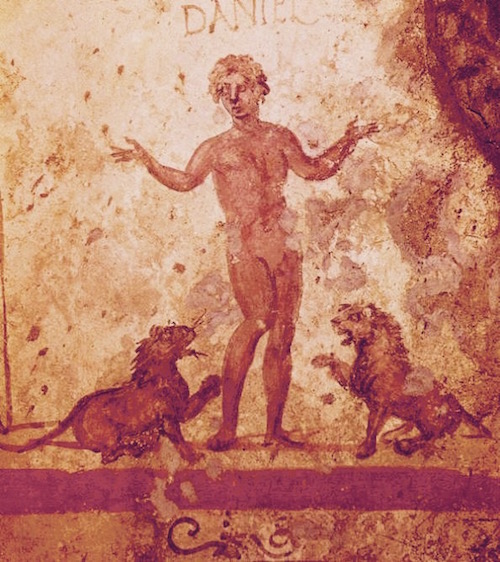

In c. 539 BC Daniel, who had been captive in Babylon for c. 60 years and was in his 80’s, disobeyed a Babylonian royal decree by King Darius the Mede who had conquered Babylon in 539 BC:
”…anyone who prays to any god or man during the next thirty days, except to you, O king, shall be thrown into the lion’s den….So King Darius put the decree in writing. When Daniel learned that the decree had been published, he went home to his upstairs room where the windows opened toward Jerusalem. Three times a day he got down on his knees and prayed, giving thanks to his God, just as he had done before.” Daniel 6:7, 9, 10
Daniel was discovered praying to God in open defiance of the king’s decree and was thrown into a den of lions.
“When the King returned the next day, Daniel was alive: “My God sent his angel and he shut the mouths of the lions. They have not hurt me, because I was found innocent in his sight.” (Daniel 6:22)


Darius was so overwhelmed at the power of Daniel’s God that he issued a decree:
“I issue a decree that in every part of my kingdom people must fear and reverence the God of Daniel. For he is the living God and he endures forever; his kingdom will not be destroyed, his dominion will never end. He rescues and he saves; he performs signs and wonders in the heavens and on the earth. He has rescued Daniel from the power of the lions.” Daniel 6:26, 27
About 60 years earlier, another Babylonian King, Nebuchadnezzar, had been so astonished at God’s deliverance of Shadrach, Meshach and Abednego from the fire that he had issued a decree forbidding anyone to defame Israel’s God. (Daniel 3:29) King Darius’ response to Daniel’s deliverance from the lions went even further. He formally decreed that Daniel’s God is a living God whose dominion and wonders will never cease. Perhaps someday archaeologists will find remnants of the decrees of these two Babylonian kings.
Daniel was an obvious Old Testament hero of the faith who, like the early Christians, had been thrown ad bestiam (“to the beasts”), to the lions because he would not worship a false god. Some bones found in the catacombs have teeth marks from gnawing beasts on them (below).
Like the Holy Children in the flames, Daniel is always represented “in the midst of” his ordeal. The outcomes are not what inspired the Christian believers. It was faith in the jaws of death that gave them hope. They needed that existential immediacy.
There is only one very small painting of David in the catacombs. It is in the Catacomb of Domitilla on a panel in the ceiling. A very small David with his sling swinging from his right hand “gets ready” to slay a very large Goliath:
“A champion named Goliath, who was from Gath, came out of the Philistine camp. He was over nine feet tall. He had a bronze helmet on his head and wore a coat of scale armor of bronze weighing five thousand shekels (125 lbs.); on his legs he wore bronze greaves, and a bronze javelin was slung on his back. His spear shaft was like a weaver’s rod and its iron point weighed six hundred shekels (15 lbs.)
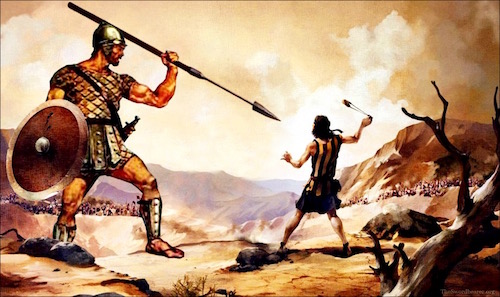
 “….David said to (King) Saul, ‘Let no one lose heart on account of this Philistine; your servant will go and fight him’….Then (David) took his (shepherd’s) staff in his hand, chose five smooth stones from the stream, put them in the pouch of his shepherd’s bag and, with his sling in his hand, approached the Philistine.
“….David said to (King) Saul, ‘Let no one lose heart on account of this Philistine; your servant will go and fight him’….Then (David) took his (shepherd’s) staff in his hand, chose five smooth stones from the stream, put them in the pouch of his shepherd’s bag and, with his sling in his hand, approached the Philistine.
“….David said to (Goliath), ‘You come against me with spear and javelin, but I come against you in the name of the Lord Almighty, the God of the armies of Israel, whom you have defied. This day the Lord will hand you over to me….All those gathered here will know that it is not by sword or spear that the Lord saves, for the battle is the Lords’….Reaching into his bag and taking out a stone, (David) slung it and struck (Goliath) on the forehead. The stone sank into the forehead, and he fell facedown on the ground….David ran and stood over him. He took hold of the Philistine’s sword and drew it from the sheath. After he killed him, he cut off his head with the sword.” I Samuel 17:45-48, 51

David was “ready.” The Christian soldiers were ready, too. In 313 Constantine’s Edict of Milan gave them the “freedom to worship.” They had won. Without a standing army or a sword, the Christians and their faith in God triumphed over and came into possession of a Goliath—the whole Roman Empire.
 The power of the catacomb frescoes is not in the greatness of their execution but in the subject matter of the paintings. Old and New Testament stories remain fixed upon the crumbling underground walls. Noah pleads and praises from his little ark. Complicated, morose Jonah hangs his head under the fig tree. The toddler Jesus sits upon His mother’s knees with outstretched arms to receive the gifts of the Magi (left—Catacomb of Priscilla c. 250 AD).
The power of the catacomb frescoes is not in the greatness of their execution but in the subject matter of the paintings. Old and New Testament stories remain fixed upon the crumbling underground walls. Noah pleads and praises from his little ark. Complicated, morose Jonah hangs his head under the fig tree. The toddler Jesus sits upon His mother’s knees with outstretched arms to receive the gifts of the Magi (left—Catacomb of Priscilla c. 250 AD).
 Moses strikes the rock in Horeb and water gushes out to baptize Roman centurions. The Three Holy Children in the midst of the fire lift their hands in praise. The paralytic walks away with his straw pallet on his shoulder; the inquisitive Samaritan woman stands at the well; the Eucharist bread is blessed called imposito manum, “the laying on of hands, the blessing of the Communion bread.” (Right—Catacomb of Callixtus)
Moses strikes the rock in Horeb and water gushes out to baptize Roman centurions. The Three Holy Children in the midst of the fire lift their hands in praise. The paralytic walks away with his straw pallet on his shoulder; the inquisitive Samaritan woman stands at the well; the Eucharist bread is blessed called imposito manum, “the laying on of hands, the blessing of the Communion bread.” (Right—Catacomb of Callixtus)
Thousands of paintings are silent witnesses to modern observers that these people, these events happened and meant something yesterday to a persecuted people. They have stood and will stand as crude, dark and quiet testimony to the faith and the eternal truths that sustained a periled people.—Sandra Sweeny Silver
Hebrews 11:1
“Faith is the reality of what is hoped for, proof of what is not seen.”
